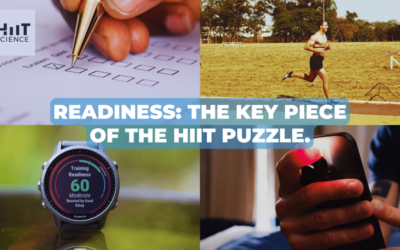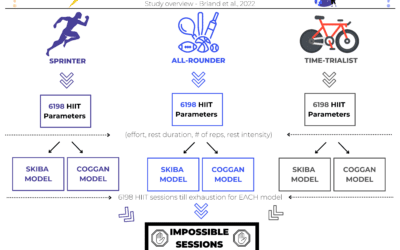We probably get that question the most at HIIT Science. It’s an important issue to be clear on, because understanding HIIT Types opens a window of opportunity for understanding solutions to your programming puzzle.
If you’re new to HIIT Science, our key figure, shown here as Figure 1, can appear busy at first glance and may be a bit daunting – we appreciate that. But this Google Earth viewpoint provides us with our HIIT Type road map solution. Appreciate the concepts, apply them in your programming, and you’re on your way to better outcomes.

Figure 1. THE key figure of HIIT Science. Once context is determined, use this flow chart to consider your HIIT target based on the desired level of oxidative, anaerobic or neuromuscular response. From these targets, select your HIIT weapon accordingly.
Let’s summarize the figure in a paragraph. Remember, as Martin lead off with in this blog series, be clear on
objectives before content first and foremost. Once the context is clear, take the 3 key physiological targets you want to be developed (aerobic, anaerobic, neuromuscular), and determine how each system would be maximized if you were to individually target the response (e.g., train it). Then, simply select the weapon of your choice to hit your targets.
Back to answering our overarching question: there is probably one key reason we need to think this way – thinking target type first. Predominantly it relates to the fact that these different physiological systems, get taxed to different degrees, depending on how any training session is performed.
Want an example? Okay. Let’s imagine isolating only the neuromuscular/ musculoskeletal system. Envisage receiving a stressful hit on your neuromuscular/ musculoskeletal system – day in day out – session after session. As per Figure 1, these would all be HIIT Types #2, 4, 5, & 6. I’m sure you can imagine how this would likely result in a train wreck for most individuals. More often than not, we need substantial periods of recovery (often days) between such sessions to allow the neuromuscular/ musculoskeletal system to adapt appropriately (think how long it takes for muscle soreness to go away).
But what about those other systems (aerobic/anaerobic)? If they need development also, surely there must be a way we can continue to push them ahead whilst still recovering our neuromuscular system? And fortunately, there is. Follow our roadmap figure to see how (Figure 1).
As shown, we can, in fact, continue to develop these other important systems through the insertion of the appropriate HIIT training weapons that target Type #1 and #3 responses (see examples).

Such target types come from HIIT weapons with a low involvement of neuromuscular/ musculoskeletal strain.

Of course, the anaerobic system needs its recovery periods as well. So the same target type mindset can now bring you the awareness to adjust your programming. Lower stressing Type #1 sessions can be inserted to enable recovery and aerobic development as needed.
Put simply, understanding the key physiological responses of different HIIT sessions enables you the ability to place the right session, in the right place, at the right time, in order to maximize the development of the physiological capacities you’re after. Our
book and
course are available to help guide you.
To close this post, let’s go back to our underlying question. Why the HIIT Types? Because appreciating the diverse range of underlying physiological responses that HIIT can target, offers you a far better chance of solving your programming puzzle.
Make it happen.

 Such target types come from HIIT weapons with a low involvement of neuromuscular/ musculoskeletal strain.
Such target types come from HIIT weapons with a low involvement of neuromuscular/ musculoskeletal strain. Of course, the anaerobic system needs its recovery periods as well. So the same target type mindset can now bring you the awareness to adjust your programming. Lower stressing Type #1 sessions can be inserted to enable recovery and aerobic development as needed.
Put simply, understanding the key physiological responses of different HIIT sessions enables you the ability to place the right session, in the right place, at the right time, in order to maximize the development of the physiological capacities you’re after. Our book and course are available to help guide you.
To close this post, let’s go back to our underlying question. Why the HIIT Types? Because appreciating the diverse range of underlying physiological responses that HIIT can target, offers you a far better chance of solving your programming puzzle.
Make it happen.
Of course, the anaerobic system needs its recovery periods as well. So the same target type mindset can now bring you the awareness to adjust your programming. Lower stressing Type #1 sessions can be inserted to enable recovery and aerobic development as needed.
Put simply, understanding the key physiological responses of different HIIT sessions enables you the ability to place the right session, in the right place, at the right time, in order to maximize the development of the physiological capacities you’re after. Our book and course are available to help guide you.
To close this post, let’s go back to our underlying question. Why the HIIT Types? Because appreciating the diverse range of underlying physiological responses that HIIT can target, offers you a far better chance of solving your programming puzzle.
Make it happen.





